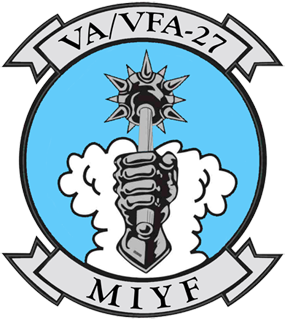

VA/VFA-27 Royal Maces



 Squadron Stories
Squadron Stories

 Dick Dreiling, 1967-70 WestPac/Vietnam:
Dick Dreiling, 1967-70 WestPac/Vietnam:My name is Dick Dreiling, CWO-4 (Ret). I was one of the plank owners in VA-27.
I was assigned to VA-27 as part of the commissioning crew in 1967. I was a fresh caught Aviation Electronic Technician WO-1. When I arrived at NAS Lemoore in July 1967, there was no squadron, and no aircraft, only a couple of office spaces. I worked alongside the prospective Maintenance Control Officer, LT John Witten (LDO) ordering all of the publications we would require to be able to maintain the aircraft. We also plagiarized all of the instructions and notices we could from VA-146 and VA-147.
When we finally started getting more maintenance troops and aircraft, we began to organize as an actual squadron. If I remember correctly, we were commissioned on 1 September 1967. I was then detached to go to Warrant Officer School in Pensacola. Florida. Upon completion of "Knife and Fork School," I returned to VA-27 and served as Avionics Officer until 1970. I had advanced to CWO-2 while in VA-27.
We made the usual workup deployments to Fallon, then embarked onboard USS Constellation as part of Carrier Air Wing Fourteen for our first combat cruise to Viet Nam. With our sister squadron, VA-97, we were the third and fourth A7A squadrons to deploy to Yankee Station. VA-146 and VA-147 were the first two.
During our first combat cruise, the skipper's aircraft was hit while he was prosecuting a target in the north. He was able to get feet wet, then fly south to Danang. Since the damage to the aircraft was causing hydraulic fluid to stream from the aircraft, and the hydraulic fluid was on fire, he had to keep his airspeed up to keep the fire behind him. As a result, he had to come in 'hot' for a landing. When he touched down, he tried to apply the brakes, but the wheels locked up and the tires and rims were ground down to the hub. At that time, the main mounts snapped off and he was still traveling quite fast down the runway sliding on his belly with only the nose wheel steering to keep him on the centerline. The aircraft began to depart he runway, so he was forced to eject. Thanks to the zero-zero seat on the aircraft, he landed safely, receiving only minor injuries. The aircraft went off the runway and headed directly for an aircraft hangar full of Marine maintenance troops. Fortunately, they scattered like the wind just as the aircraft attempted to enter the hangar. I say attempted, because the wing of the plane hit an upright between the two hangar bays. The plane spun around the stanchion and sprayed the inside of the hangar with burning fuel and what was left of the hydraulic fluid in the plane.
Because we had a severe shortage of spare parts for the A7A's, I was sent from the ship to Danang to salvage whatever could be saved and to ensure that there was no classified equipment remaining in the aircraft. During this trip in-country, I experienced 'in-coming' and quickly remembered why I was in the Navy and not the Army or the Marines. I was awakened by two or three bangs, then was almost thrown out of bed with a third one. The alarm was sounded and we were all told to get out of the barracks and get into the air raid trench. It seemed the Viet Cong was throwing mortars or rockets into the base. There were no more explosions, but the third and loudest one had hit the corner of a shelter and sprayed shrapnel into the nearby barracks, killing a man sleeping there.
When we returned from the second cruise, we found the squadron was to transition from the A7A to the A7E aircraft. My job was to establish a program and schedule to cycle all of the personnel through VA-122 for retraining. When I finished the schedule, I was transferred from the squadron.
It's good to find the squadron is still "on the front lines" and showing the fleet what a good squadron is all about.
 Rich Powell, 1968-69 WestPac/Vietnam:
Rich Powell, 1968-69 WestPac/Vietnam:Plankowner; wasn't it fun writing all those new directives (Thank God for the Argonauts!). Remember, we were the ONLY Sqd to bring back all our drivers - each cruise (lost some A/C, tho). Pete Walden, landed aboard "Connie" with the big hole in the wing; Jim Lee - bad hit, but made it out to just offshore NVN & was recovered; Skipper Pappas, battle-damaged divert, crashlanded and ejected in Da Nang, darn near took out a Hanger; Rod Karp, shot down over Laos, picked up by the CIA helo (Air America) - he was so happy to see them that he gave them his pistol (got some grief for that!); Bud Biery, a SAM got him while trying to fire his Shrike at night, then his raft wouldn't inflate, but they got him back to the ship. He was the "spare," but I was boxed in by a down A/C, so they launched him. I went down to watch the movie, quite pleased with the turn of events, at least 'til the word came down about his shoot-down; had a whole different perspective on it then. We're still friends, tho.
 July 1968 Vietnam:
July 1968 Vietnam:VA-27's A-7A BuNo 154344 Modex:601 recovers aboard USS Constellation in July 1968, its pilot having expended the aircraft's rocket's and bombs. Two months later, on 14 September 1968, this aircraft was hit by flak during an attack near Vinh. The pilot, VA-27 CO Cdr George Pappas, made an arrested landing at Da Nang, but the A-7 veered off the runway and was destroyed by the subsequent fire. Cdr. Pappas successfully ejected and landed nearby the blazing wreckage.
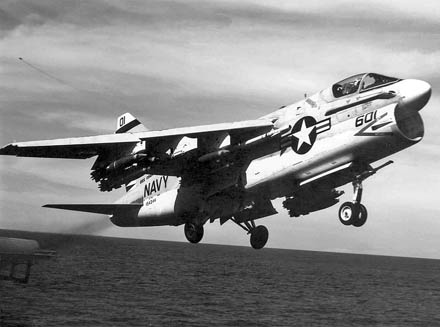
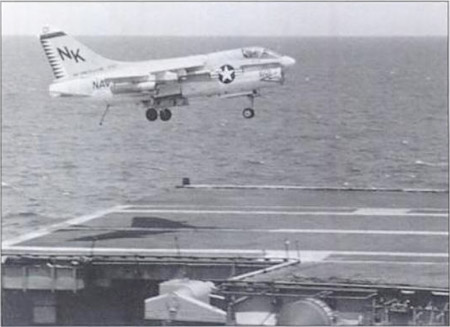
 1968 Vietnam:
1968 Vietnam: Rich Powell, 1968-69 WestPac/Vietnam:
Rich Powell, 1968-69 WestPac/Vietnam:Plankowner; wasn't it fun writing all those new directives (Thank God for the Argonauts!). Remember, we were the ONLY Sqd to bring back all our drivers - each cruise (lost some A/C, tho). Pete Walden, landed aboard "Connie" with the big hole in the wing; Jim Lee - bad hit, but made it out to just offshore NVN & was recovered; Skipper Pappas, battle-damaged divert, crashlanded and ejected in Da Nang, darn near took out a Hanger; Rod Karp, shot down over Laos, picked up by the CIA helo (Air America) - he was so happy to see them that he gave them his pistol (got some grief for that!); Bud Biery, a SAM got him while trying to fire his Shrike at night, then his raft wouldn't inflate, but they got him back to the ship. He was the "spare," but I was boxed in by a down A/C, so they launched him. I went down to watch the movie, quite pleased with the turn of events, at least 'til the word came down about his shoot-down; had a whole different perspective on it then. We're still friends, tho.
 Dave Lesser, 1969 WestPac:
Dave Lesser, 1969 WestPac:Now this ain't no s***!...(this time it really isn't...there must be an official Officer type record somewhere to prove it)...I joined VA-27 at the end of their first WesPac cruise on the Connstellation in January 1969 after having made that cruise in VA-196 as an unrated airman working as an AO....I swapped duty with a guy named Smithhurst whose home was in Tacoma, Washington...My home was in Glendale California....VA-27 put me in the Line Shack and trained me as a Plane Capt.....After several months the Officers were flying touch and goes at Lemoore one night and they were doing "hot seat turn-arounds" fueling and switching pilots as needed, without shutting the engine down in the fuel pit....Several of us were working that night, myself and as I remember Danny Sherman and a guy named Emler I think and possibly John Boone, several others whom I can't remember....I was working the fuel hose on a bird, the pilots always folded wings when they pulled into the pits....The pilot who pulled in had gotten out and the next pilot to take the bird out was Ltjg Williams.... got in the cockpit...we finished topping off the bird...and cleared out of the way...Danny directed the A/C out of the pits and I think gave some brief turn-up checks....There was another of our birds ready to pull into the pits and you know Officers don't like to be kept waiting... after the checks Danny gave Mr. Williams...unfold wings...off brakes....come forward...and pointed him off towards the active, a salute and ran back to pull the next bird into the pits....Mr. Williams then taxied out to the end of the runway and did whatever pilots do ...I guess talked to the tower.... got clearence and all that pilot stuff....and no one noticed that he had never actually unfolded his wings....turned up the power and started his take off....everything was cool...until his wheels left the ground....as soon as he was airborn...both his wing tips crashed inboard from their normal 90 degree....to maybe 60 degrees....you know all the hydralic lines that are in the elbows of the wings...all of them broke and ever light in the cockpit went red and all the buzzers and stuff sounded because of the massive PC failure...As dumb as he had been up to that point his excellent flying ability took over and having a lot of altitude already....maybe a hundred feet off the deck......he could have punched out...with the A-7's 0-0 seat...but he didn't...he stayed in the bird and side slipped around 180 degrees to port....you see he actually had three tails and three rudders now...however no alierons....as he came to the end ot the runway that he had just taken off from he did another 180 turn...made his approach...and landed...perfectly....when the bird came to a stop out on the runway...he shut down the engine...and opened the cockpit and just jumped out....not a sctatch on the bird...except for a mil-h-5606-b hemmorage from the wing elbows...and not a scratch on him...or anyone else....He then just walked back to the hanger....Obviously there was a big investigation...lots of Officer types questioned everybody within sight or hearing...I don't know what they came up with but none of us Plane Capts got in any trouble cuz we had done our jobs....maybe Danny Sherman got an ass chewing but I think that was all...and Mr.Williams went on to make the 69-70 WesPac with us.....As I remember he was a good pilot and unlike some other pilots.... always took your bird out and brought her home...hardly ever downed a bird....I always wondered what ever happened to him... I don't remember what happened to the bird...it was around the hanger for a while ...then who knows....And thats the true story of the little A-7 that could...and how "Wings" Williams got his name.....I know...cuz I was there.....Dave Lesser.
A follow up to Dave Lesser story about Lt. (Bent Wings) Williams. First of all I was there and the story is true. After the incident, Steve McQuery, Airman working in the AK shop was ordering parts so Airframes could fix the plane. He needed to order a small part for the wing, but could not find the correct part number, so instead he used the part number for the entire wing. A couple of weeks later a semi tractor trailer pulled up in front of the hangar with a complete wing assembly. Who said our supply system didn't work....John Pfannenstiel.
 Rodd Karp, 1970 WestPac/Vietnam:
Rodd Karp, 1970 WestPac/Vietnam:My dad flew in VA-27 when it was first born... from 67-69 or 70 or so. His name was Raleigh (Rod) Karp. His call sign was Pygmy because he was not very tall (5'6" or so). On his second cruise, he was shot down over Laos and rescued. Here are the offical reports on on the SAR that rescued Lt. Karp:
 Tom Knudson, 1971 WestPac:
Tom Knudson, 1971 WestPac:[Reprinted with permission from the A-7 Corsair II Association]
Dungaree Beach - A Sea Story:
At the urging of my VA-27 roommate, Jim Larkin, I offer up this story for your Sea Story Archives. It is not a combat story, so fast forward if you are not interested.
VA-27 had completed a couple of line periods in 1971, and I, as the AVWEPS division officer, could not have been prouder of my division, especially the Ordies who worked for me. As we all remember from that time, many were not particularly the brightest bulb in the box, but with a hernia bar, they humped 500 and 1000 pounders onto the racks of our Corsairs day and night and, for the most part, without complaining.
On our second in-port period in Cubi, I, as a thoughtful and empathetic division officer, decided to throw a beer bust for my men on dungaree beach. For those of you who spent time at Cubi will recall, it was snuggled up just south of the runway which ran 07/25. It was all fill, so to get around the runway you had to take a road which traversed the perimeter. I arranged for a bus to take us from USS Enterprise, which was tied up at the carrier pier at Cubi, to dungaree beach. I also arranged for a bus to pick us up at 1800, but that didn’t work out so well.
We had tons of beer, hot dogs, burgers, and, as always happens at these sorts of events, I got thrown in the bay countless times. I was tremendously proud of the esprit-de-corps of my division, and we had a fabulous afternoon on the beach.
Around 1800, when the bus was scheduled to pick us up, there was no bus in sight. I made a number of calls, but no dice! Those of you who were there at that time may remember stories of pirates and thieves working Subic Bay. So, I decided that, come hell or high water, I needed to get my troops back to the Enterprise, even if it meant walking back. Having made the call to hoof it, my Chiefs rallied the troops and pointed them towards the superstructure of the Enterprise, which we could see in the distance. The only problem was that the direct route took us straight across the runway.
Seeing what was about to transpire, I frantically tried to get everyone rerouted to the road which ran around the runway, but it was too late! Half my troops were already up on the runway, so I gathered up the stragglers and pressed on. About the time that the majority of us were in the middle of the runway, we saw flashing lights and heard the sound of (what turned out to be) a C-141 making an emergency go-around. That was, of course, necessitated because of me and my Ordies being in the middle of the runway. Turns out, it was an Air Force Three-Star who got the go-around and who was not terribly pleased.
The Shore Patrol quickly rounded up my Ordies and me and hauled us to base headquarters. I pleaded for transport to take them all back to the big E and let me hang around and take the heat, which remarkably, that is just what they did. After a royal ass-chewing by the OD, I was transported back to the Enterprise with the admonition to be at the Base CO’s office at 0900 the next day.
At about 0700 the next day, my squadron CO, Jerry Johnson, woke me up to tell me to get into trop whites and join him for a meeting with the Enterprise XO, C.C. Smith. We did, and it was all the XO could do to not burst out laughing at the story. We went on to meet with the CO of Naval Station Cubi Point, where we had a similar experience of stifled laughter.
When we got back to the ship, skipper Johnson said “when are we supposed to head back to the line?” I replied that it was in three days. He replied, “OK, four days from now, you’re in hack for three days!”
Six months later we were in port in Singapore and I found myself at the bar with Enterprise XO, C.C. Smith. He regaled me with his own version of the story, which by now had grown a bit. I could not buy a drink that night.
The punch line of the story is that the enlisted guys who worked for us in those days made almost nothing – if they were married, they were eligible for food stamps. America had young people who, without a lot of sophistication or credentials, carried us through so much of that terrible conflict. I continue to be astonished at the dedication and patriotism of the young men (in those days only men) who played a pivotal role in our ability to fly mission after mission, day after day.
If I had it all to do over again, I would do the same thing, and hope that the same Air Force 3-Star got waved off once more!
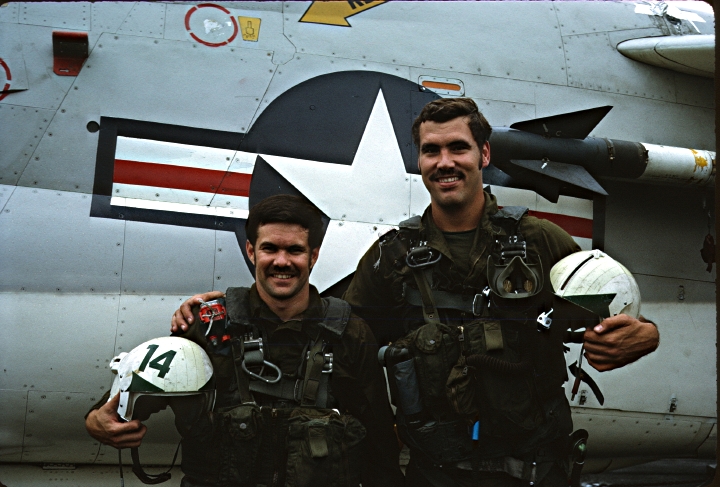
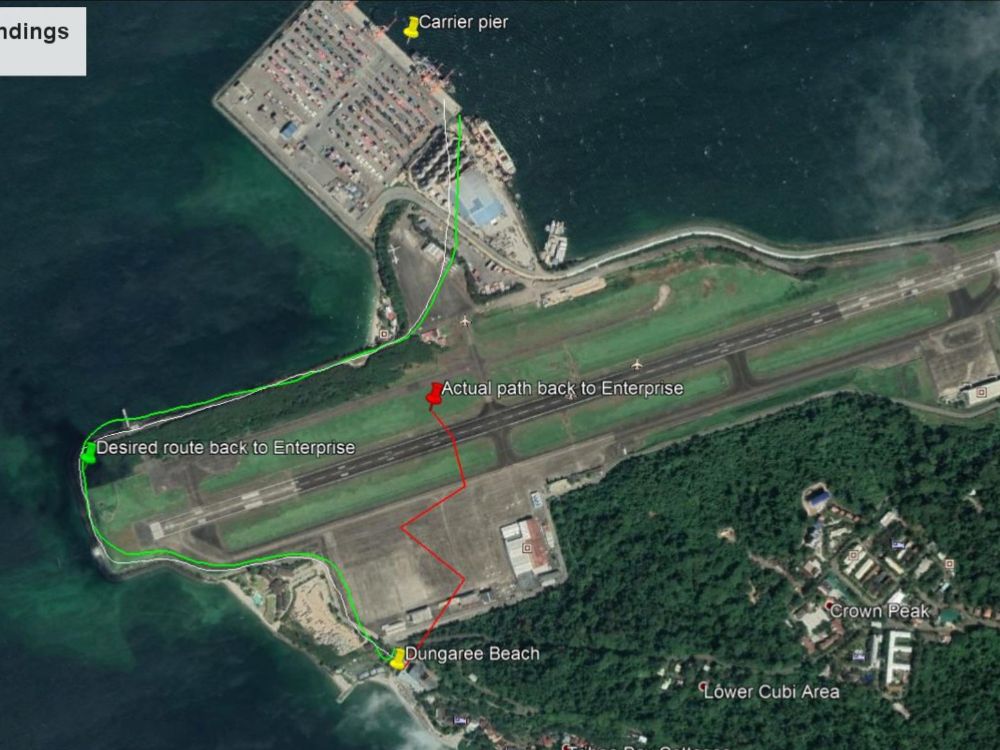
Blessings to my fellow SLUF drivers,
Tom Knudson
 Bob Dorais, 1979-80 WestPac:
Bob Dorais, 1979-80 WestPac:We were in San Diego for workups. I didn't see this one, but my shipmate Kevin Burke saw it right after it happened. We were tied up at the pier. It was late afternoon and most everybody was in town getting some culture. Some swab was up on the flight deck on a work detail near the fantail. About that time a boat full of "brig bate" came alongside the ship in a small boat. They were yelling up to guys on the flight deck. They started to remove strategic articles of clothing and things got heated up. It was more than that one sailor could take. He yelled to the girls that he would be right down. And with that he took a flying leap right off the flight deck. He hit the water so hard that it knocked him out. Lucky for him he surfaced right away and some guys on the dock jumped in and got him. I can only imagine the duty he pulled for the cruise after that.
Ah, beautiful Hawaii. What a liberty call this will be. NOT! Here we are, two days out of Pearl and the s*** hits the fan in South Korea. Their president is assassinated and the North Korean's are suspected. To prevent chaos, we are ordered to steam immediately to South Korea for a show of force. But, the ship still must stop at Pearl to take on supplies. All liberty is canceled and everyone is to remain on board while we get supplied. So there we are, looking around the harbor and taking in the beautiful land that we'll never set foot on. I'm down on the hanger deck after an hour or so of doing nothing when a Chief comes along asking for volunteers to hump some trash to the dumpsters on the dock. It would be my only chance to set foot in Hawaii so I did it, I set foot on Hawaii, sort of. We were in port for a total of six hours. Not fair!
We were sent to the Indian Ocean when two major crises were occurring in that part of the world. The Russians had just invaded Afghanistan and the Iranians were still holding American hostages. We were at sea for a total of 102 days, nearly all of that being spent playing cat and mouse with the russkies off the coast of Iran. On one particular fly over of a Bear, an F-4 Phantom was sent up to meet and escort them out of the area. The Russian pilot was signaling with his hands to the American pilot to turn his radio to a certain frequency. The American pilot did it not knowing what could be up. The Russian pilot proceeded to congratulate the Americans on defeating the Russians in the finals of the Olympic hockey game. And that's how we got the word that we had won the "miracle on ice" hockey game.
Still in the Indian Ocean. Soon after the Olympic victory we finally get a stand down day. "Steel beach" is in full swing when a Russian destroyer starts to approach the ship. For whatever reason we didn't launch the Alert 5 aircraft. They soon were closing fast from the stern on the starboard side. Everyone on the Coral Sea crowded the starboard deck edge as the Russian ship slowed down and came along side. I guess they were trying to show us their stuff because a lot of their crew were in their dress blues manning the port rail. Well, it didn't take long before 4000+ proud American sailors started hurling every obscenity know to man at these guys. Then it progressed to flipping them the bird. And the grand finale was a mass "mooning". The noise from the hootin', hollerin' and belly laughing was amazing. Those Russians must of thought we were the most undisciplined crazy group of nuts on the planet. The old man never said a thing about it. Hell, he was probably on the bridge giving their skipper the single finger salute. Wish I had a picture from the Russian ship looking at the Coral Sea, what a site that must have been.
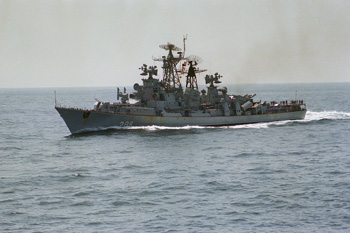
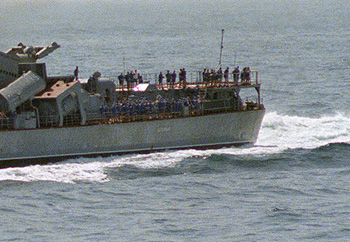
Still in the Indian Ocean. The hostage rescue mission had just ended and ended tragically for some of the rescue force. Keep in mind that there were two carrier task forces on station for this operation, us and the Nimitz. Of course the Nimitz was the show boat of the fleet so all the brass and media were on board her. No one wanted the old girl, the Coral Sea, to host all the hot shots. So there we were, mad as hell that our mission failed. All of a sudden a steady parade of S-3 Viking COD's start coming aboard. We also get an UNREP in the middle of all this. Well low and behold, pallets of beer are starting to pile up on the deck right next to the island. Woo Hoo! This must be our reward for flying non-stop for months and our part in the rescue mission, right? Wrong! That beer sat right there with someone assigned to watch it, probably a MARDET grunt. The next day, right under our noses, helicopters from the Nimitz start picking up the suds and flying it over to their ship. The party was on for the Nimitz boys and all the brass over there. We didn't get a drop! I actually worked with a guy that was on the Nimitz back then and he remembered the beer party and the fact that they were all laughing about how pissed the Coral Sea guys must have been. He of course agreed that he owed me a few beers.
Still in the Indian Ocean. We are being relieved by the Constellation. As a part of the day the Connie put on an air show for us. Right at the end of the show their squadrons formed up for an airwing flyover. Before they made their approach another plane appeared off the port stern. It was a Russian bear being escorted right by us. Just about that time the airwing came up right behind the bear and just a little above him. The airwing overtook the bear and as soon as they did the bear put it to the fire wall and bugged out. That russian pilot must of dropped a load.
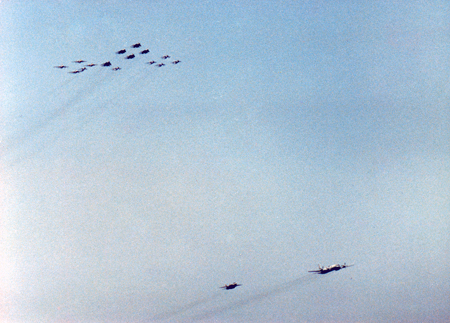
Liberty in Olangapo City. In 79/80 there was midnight curfew. The base would blow a ten minute warning horn and then another at the stroke of midnight. Many a night when the midnight horn blew and we were still out on the town. You know how hard it is to get a sailor off a bar stool! It was like a rodeo, the Shore Patrol jeeps would come flying up main street to try and nab sailors. It was funny as hell. Sort of like turning on the lights in the kitchen at midnight and watching the cockroaches scatter. We would run like hell and dive into the nearest hotel for the night. Once I got chased right up the steps of a hotel with two SP's hot on my heels. The old man behind the desk waved me through a doorway and closed it behind me. The SP's were yelling at this guy but he played dumb. Close one.
Some Ocean. It's the middle of the day and a launch cycle just completed. An A-7E Corsair II is being brought up on the forward starboard elevator. A plane captain is in the cockpit riding the brakes. The pilot and a couple of us squadron guys are waiting at the elevator because that's where it's going to be spotted for the next launch. The elevator starts up and I hear the pilot say something about the "headknocker". Sure enough, the head knocker is up, which means the ejection seat is armed and dangerous! I guess the plane captain didn't like it poking into his head so he moved it up. The plane arrived on the roof. The safety cable lowered. And the pilot took about two steps and jumped up to the cockpit. Before he strangled the plane captain he lowered the head knocker. He proceeded to scream at this kid about ejection seats and being stupid and caused a big scene. Never saw a pilot lose it like that.
Here's one that I actually fell for. Keep in mind that you could actually bring visitors aboard at certain times while the ship was in port(note my pitiful disclaimer). We had just pulled away from Cubi and were heading back out to sea. We were in the AE shop when some of our AM guys stopped by. They were all excited. "Did you guys hear? They found a stowaway below decks. One of the snipes had her hiding down there for days." "Really?" I said. "Yeah, there going to helo her back to the base as soon as the deck is ready. Let's go topside and see if we can get a look at her." "OK" I said. And with that we hauled butt up to the roof to see the festivities. Of course when we got up on the flight deck there was nothing going on. Except about six guys laughing their asses off at me!
VA-27 Corsair II coming in for a landing. He caught the wire and started traveling up the deck. Then "snap", the tail hook broke off. He of course was at full throttle and just barely had enough speed to lift off again. He dumped fuel and came around for a perfect landing into the barricade.
VA-27 Corsair II returning from a sortie. He flew over the carrier broke left and deployed his speed brake. He put his gear down and got in the pattern for a landing. That's when he noticed that his speed brake would not come back up. On the A7-E the speed brake extends well below the landing gear. He circled the ship and dumped fuel. It was decided to try a barricade landing. This was very risky because if he put it down even a little bit off it could roll and crash. I remember being on the hose team just forward of the island. I thought, "great, this is about where the fireball and wreckage will come to a stop". He lined up and drove it right down the center line. As soon as he got over the round down he cut power and set it down hard. The speed brake touched first but the pilot held it level. He just kept going into the barricade and grinding down the speed brake until the wheels hit. He came to a stop right in front of our hose team and hot footed it out of the cockpit. Other than the huge trail of sparks, the landing was perfect.
 Greg Lake, 1984/85 WestPac:
Greg Lake, 1984/85 WestPac:We were under way in the west pacific during night operations and there was a cloud deck about thirty feet off the flight deck and in some of the heaviest seas that we experienced on westpac 84/85 and recovery operations were really hairy, needless to say, tankers had to be sent up because of all of the bolters that were happening. I ,being the plane captain on bird no. 401 that the skipper (CDR. H.D.Connell) was flying, only made one approach at the deck that night because he grabbed the three wire right off. Which made me proud to be a mace.
 Ron Mulcahy, 1986/87 WestPac:
Ron Mulcahy, 1986/87 WestPac:We were on WestPac '86-'87 aboard the U.S.S. Carl Vinson under the leadership of CDR J.P. Sciabarra, and as an AMEAN, it was a rare priviledge to be put in the position of a troubleshooter up on the flight deck, as that is usually an N.C.O. responsibility. We were flying ops north of the Aleutian Islands in January, which at that time was a first for any carrier, when we had a situation with one of our sister squadrons A-7e corsairs. During the final wipedown of the plane, the troubleshooter noticed that there was a hydraulic leak in the brake system, so we grounded the bird. Well, I guess noone informed the yellowshirt who wanted the pilot to taxi the downed bird to the elevator, so it could go to the hangar bay for repairs. Before anybody knew what was going on, the yellowshirt started taxiing the plane out of its' space--WITHOUT ANY BRAKES! To this day, I'll never forget the look on that pilots' face as he realized that there were no brakes. I do remember that there was one SeniorChief who tried to run up and throw a set of chocks under the wheels, but the plane was moving too fast and kicked the chocks right back at him. It was such a frustrating feeling, because all we could do was watch the plane getting closer and closer to the edge of the ship. The plane was just about to the edge when --WHOOSH!! The pilot ejected. The plane just continued over the side, and into the ocean. The pilot went over the side as well, but search and rescue was dispatched immediately, and he was retrieved in a matter of minutes. Even now, I can remember the appreciative look on that Ltjg.s' face when he bought us a case of beer, once we got back into port.
 I Walked Off the End of the Flight Deck… Into the Sea!
I Walked Off the End of the Flight Deck… Into the Sea!After serving on three different aircraft carriers and working the night shift for the majority of my four-and-a-half years in the Navy, I was no stranger to operating around the flight deck at night. While on deployment near the Great Barrier Reef of Australia, I had no real concern about volunteering to participate in a night flight-deck scrub-down (SCRUBEX).
I grabbed my float coat and cranial and headed to the island for muster with the FOD team. However, before going to the flight deck, my supervisor stopped me and made sure I did a full inspection of both my float coat and my cranial. I then put on my personal protective equipment (PPE) and went to the SCRUBEX.
Once on the flight deck, I noticed it was an especially dark night. A thick layer of clouds obscured the moon and stars. After muster, everyone lined up along the forward edge of the landing area on the port side of the ship. As I moved along the line of people to take my position on the far port side, I was looking toward the stern, not really paying attention to where I was going. I reached the end of the line and took an extra step toward what I thought was a few more feet of flight deck. However, I suddenly realized nothing was beneath my feet but night air. Confusion gave way to concern as I tumbled through the air. I just had stepped off the edge of the ship and was falling into the sea.
I yelled all the way down and kept yelling as I smacked the water on my left side. I instantly was submerged, but, just as quickly, I was forced back above water when my float coat inflated automatically. With my head above water, I was able to spit out some of the saltwater in my mouth and took a deep breath. I needed the air to continue yelling and waving my arms at a group of Sailors on the smoking sponson.
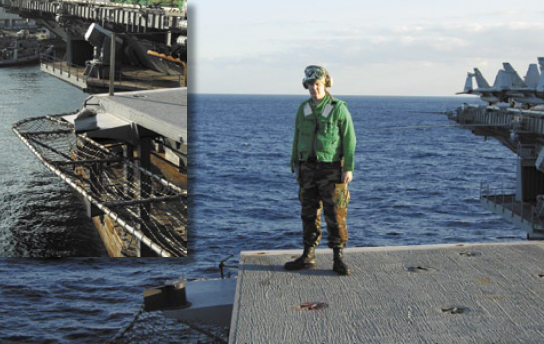
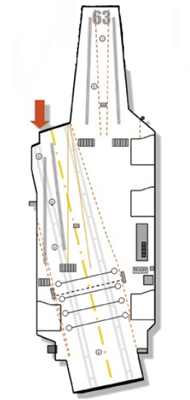
Unfortunately, no one heard me over the sounds of the ship, and I only could watch as the carrier passed by. I then located my strobe light, took it out, and activated it. I was thankful it worked, but I wasn’t sure how effective it would be because I’d already lost sight of the ship due to the rough seas that night.
Being alone in the dark and floating on rough seas is a scary and lonely experience. The only light I could see anywhere was the flashing of my own emergency strobe. I hoped that someone would spot me and that I would be rescued quickly. It seemed like an eternity had passed before I noticed the lights of a rigid hull inflatable boat (RHIB) sent to rescue me. As soon as I saw the lights and recognized the boat, I yelled and waved my arms. Once the RHIB was close to me, a rescue swimmer jumped into the water, and, before I knew it, I was aboard the RHIB and headed back to the ship.
Once aboard, I was taken to medical, where my CO and the rest of my chain of command were waiting to make sure I was OK. A full medical exam and several sets of X-rays showed no serious injuries. I was lucky to walk away with only some pain in my left leg and hip and a bruised ego. I felt like an idiot for having done something as careless and stupid as walking off the edge of the ship.
Looking back on the incident, I am very grateful my supervisor made me thoroughly inspect my PPE before heading to the flight deck. I am also happy I’d been trained to react to the situation by activating my strobe light. Later that night, I learned an airman from my squadron on the SCRUBEX detail was the only person who saw me fall overboard. He immediately went to flight-deck control and reported a man overboard. The only thing that gave away my position in the pitch-black night was my strobe light. I’m sure glad it worked.
Complacency creates a dangerous environment. All of the safety procedures—gear inspections, supervisory oversight, PPE training, and flight-deck situational awareness—are not things that should be taken lightly. My rescue at sea is proof of their importance.
 Quite a Night for the New Guy
Quite a Night for the New GuyMy day started off just like any other since arriving in Japan four weeks earlier. I had a simulator beginning at noon, followed by a SSC flight on CAG's wing later that night. It was a standard SSC brief, involving two coordinated sections searching for surface contacts along a chain of islands south of Tokyo . I was a little nervous initially, since I was new, and flying on CAG's wing without NVGs. My nervousness quickly settled down as I began to focus on the mission at hand.
There was a late lineup change that resulted in CAG and me swapping jets with the other section. My new jet was aircraft 215. The same jet that I lost brakes in just a week prior on another night flight. I quickly dismissed the thought and signed for the jet, which had already flown earlier that day without any problems, and proceeded to the PR shop to don my flight gear.
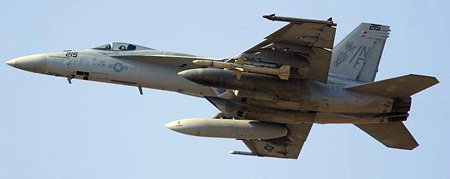
The PRs had all of my gear ready to go for my flight, to include a pair of night-vision goggles (NVGs). Knowing that I hadn't completed my squadron's NVG syllabus, I reluctantly had to hand them back. The other guys in the PR shop light-heartedly gave me a hard time for having to go out into the night “blind.” Lucky for me, it was a clear evening, with only a scattered cloud layer at two thousand feet.
After a normal pre-flight, with no discrepancies noted, I climbed the ladder and strapped in, just as the sun was going down.
The startup, taxi and takeoff were normal. We headed to the working area, about 100 miles south of the airfield. It was a little hazy at our cruising altitude, which made it challenging to maintain sight of each other, so CAG contacted the E-2 to request a higher altitude.
We received clearance to climb to 17,500 feet MSL for the transit. As we were passing through 17,000 feet, I heard a loud bang, which felt like it was under the right side of the jet. About the same time, I received a Master Caution light accompanied by an “Engine Right, Engine Right.” aural caution. Out of the corner of my eye I caught a glimpse of a R STALL caution that quickly disappeared from the Digital Data Indicator, or DDI. I pulled the right throttle back, and checked the engine page as I was discussing the indications with CAG. All of the parameters on the right motor were normal.
As I began to think everything was okay, I heard “Engine Left, Engine Left” in my headset. I immediately looked down to see an L ENG caution on my DDI. “What now?” I thought. I retarded the left throttle to idle, brought up my engine page and saw a big red >>THRUST<< staring back at me. I informed my flight lead about the new development and we both agreed it was time to RTB.
We started a shallow descending left turn down to 8000 feet and put Atsugi on the nose. After about 135 degrees of turn, I realized that I was starting to flush out in front of my lead, so I pulled the right throttle to idle to fix my acuteness. At that time, I got yet another Master Caution, alerting my attention to an L FLAMEOUT. At this point, I thought, “What else could go wrong?” I watched the RPM decay, as I struggled to keep my lead in sight.
I came back inside and looked at my Engine Fuel Display, EFD, and saw the RPM stable around 50%. It didn't match up with the right engine, but it hadn't spooled down to zero RPM either. The L FLAMEOUT caution remained. I leveled off at 8000 feet, and CAG gave me the lead for the RTB. He called back to base to have them review NATOPS and to back us up on all of the procedures. I advanced the left throttle to see if the engine would respond, but the RPM didn't increase. I told my flight lead that I still had 50% RPM and the engine wasn't responding. He then told me to go ahead and secure the left motor, which I did. Immediately I lost all power in the cockpit as the left engine spooled down and the generator kicked offline. My first thought was, i s my other generator on? After what seemed like an eternity, the displays all came back to life as the right generator picked up the load. The left engine spooled down to 0%, 300°C, and 104% on the nozzle. I had never seen a nozzle that far open before, but then again, I've never had to shut down an engine in-flight before either.
Up until this point, I hadn't been overly concerned. I had one working engine and a wingman with over 3000 Hornet hours. But with a 50-mile transit, at 250 kts, it was going to take a while. I had one engine, which had given me a stall indication earlier. Not more than two minutes later, my other engine had flamed out. A variety of scenarios began running through my head. If my right engine decided to fail me, where was I going to end up? I was fifty miles from base, at night, and over water that looked really cold.
We covered all of the specifics of a single engine landing, and contingencies for the approach. Lucky for me, the right engine was still operating, so I could lower the gear normally and wouldn't have to take a trap, which is a concern for an airwing operating at a single runway airfield. I dumped down to 5,500 lbs to lower my landing speed, and continued on for a PAR to runway 19. I was ready for the turn to final to get this interesting night over with.
I continued on with the approach at 150 kts, slightly faster than on-speed to help with controllability. As I got closer to the field, I started to slow to on-speed. As I approached my on-speed airspeed of 131 kts, I heard “Flight Controls, Flight Controls.” Uh-oh , was all I thought. I checked the FCS page, and saw a 4-channel AOA failure. Sure enough, I had no information in the HUD regarding AOA. I thought, No problem, I'll just look at the indexer. But to my surprise, that wasn't giving me any information either. So, I mashed the FCS reset button, which cleared the fault, returning all of my AOA values. However, moments later, the four-channel AOA failure returned.
After two more iterations of FCS cautions and failed resets, I realized that the jet didn't want to provide me with any AOA information for my approach. So I resorted to fly the rest of the approach fast, eventually slowing to 131 kts just prior touchdown.
After my uneventful, single-engine, no AOA approach and landing, I cleared the duty, and taxied back to my line where a group of maintainers eagerly awaited my return.
As it turns out, the night's events were the due to unrelated emergencies. The left engine flameout was the result of a failed Variable Exhaust Nozzle (VEN) pump. When the pump failed, it drove the VEN to a full open position. The outcome was a loss of backpressure to the engine, and when the throttle was moved to idle, it caused the engine to flameout. The flameout logic then tried to restart the engine, but was unable because of the failed VEN. The only way to deal with it, at the time, was to shut it down to prevent any further damage to the engine.
As for the 4-channel AOA failure, delamination of the heating element in one of the AOA probes is the suspected source of the problem. The damaged probe stuck at one AOA value, while the undamaged probe continued to move freely. Once a large enough split developed, the FCS declared the AOA input invalid and generated the four-channel failure.
Bottom-line, during flights that experience multiple emergencies, aircrew coordination between cockpits is paramount. Effective and concise communication helped identify, implement, and execute a plan to expeditiously land this aircraft in a safe manner.
Scenarios like these are precisely why we practice ACT in naval aviation.